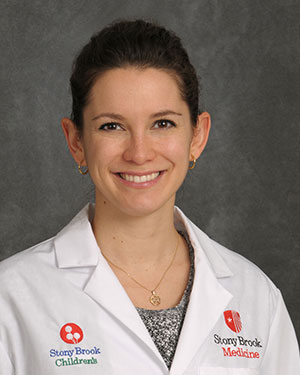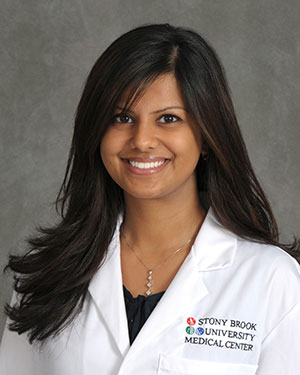Navigation Pediatric Rheumatology
Pediatric Rheumatology
Pediatric Rheumatology, which covers rheumatic and autoimmune diseases, is such a rare specialty that there are only about 300 pediatric rheumatologists in the country.
Stony Brook Children’s has two pediatric rheumatologists, and we are the only hospital in Suffolk County and just one of two on Long Island to offer this specialty for children.
Some rheumatic diseases require more aggressive treatment approaches as compared to adults. We believe our community’s children need access to specialized care. This means care tailored to the needs of children by doctors who are trained to recognize the signs and symptoms of rheumatic diseases, as well as have access to the latest research and treatment.
With correct diagnosis and aggressive early intervention, children can better manage these chronic diseases, avoid irreversible damage or lifelong complications, and participate in the typical activities of childhood.
Services
The pediatric rheumatology team provides comprehensive evaluation, treatment, long-term management and follow up of rheumatologic and immune system disorders in children. We have the expertise, experience and technology to address the full gamut of problems. This includes a fully equipped infusion unit, as well as the ability to perform joint aspirations and certain joint injections.
Because diseases of the immune system tend to be chronic, and sometimes lifelong, we work with children and families over a long period of time. We can even help transition them into adult services at Stony Brook when the time comes to ensure continuity of quality care. We also connect families with resources in the community, as well as participate in outreach efforts such as the annual Arthritis Foundation walk.
Diagnoses seen include:
- Dermatomyositis
- Juvenile Idiopathic Arthritis (JIA)
- Systemic lupus erythematosus
- Mixed Connective Tissue Disease
- Raynauds phenomenon
- Vasculitis
- Kawasaki Disease
- Henoch Schonlein Purpura
- Chronic Recurrent Multifocal Osteomyelitis (CRMO/CNO)
- Granulomatous with Polyangiitis (Wegener’ Granulomatosis)
- Polyarteritis Nodosa (PAN)
- Behcet Disease
- Uveitis
- Sarcoidosis
- Sjogren’s Syndrome
- Scleroderma (systemic and linear)
- Psoriasis
- Autoinflammatory disorders
Our Team
The core of our team consists of two physicians board-certified in Pediatrics and Pediatric Rheumatology, and a nurse practitioner. They take a multidisciplinary approach, which means they bring other Stony Brook Children’s experts onto the team as needed. This may include physical therapists, ophthalmologists, orthopaedists, infectious disease specialists and other pediatric specialists.
In addition, the team works closely with the child’s primary care doctor — not only keeping him or her in the loop through ongoing communication, but also as colleagues with the same goal: working to ensure the child has the best possible quality of life.

Locations
Center Moriches Advanced Pediatric Care
600 Main Street, Suite ACenter Moriches, NY 11934
(631) 444-KIDS (5437)
Fax: (631) 444-4990
Commack Advanced Pediatric Care
500 Commack Road, Suite 104Commack, NY 11725
(631) 444-KIDS (5437)
Fax: (631) 638-0157
Lake Grove Advanced Pediatric Care
4 Smith Haven Mall, Suite 101Lake Grove, NY 11755
(631) 444-KIDS (5437)
Fax: (631) 444-4990
Patient Resources
Our team proactively connects families with educational and community resources. We recommend the following helpful resources:
- The Arthritis Foundation
- Childhood Arthritis and Rheumatology Research Alliance
- The American College of Rheumatology
- Lupus Foundation of America
Research and Education
As part of an academic medical center, Stony Brook's Pediatric Rheumatology Division participates in the teaching of tomorrow's professionals, as well as researching immune system disorders and their treatment. Our pediatric rheumatology division is a part of the Autoinflammatory Center at Stony Brook University Hospital.
Dr. Cherian and Dr. Nuruzzaman have a lifelong commitment to advancing children’s medicine. During their respective fellowships, they worked on lupus research that contributed to their field and was presented at national conferences.
Dr. Cherian is actively involved with the Childhood Arthritis and Rheumatology Research Alliance (CARRA) and is a member of the working group for PFAPA and CRMO.
In addition, Dr. Cherian has an interest in resident/fellow teaching. She works with residents and pediatricians in training, as well as with adult rheumatologists in training, to educate them on the standard of care for children with arthritis and other rheumatologic and/or immune system disorders. She has a special interest in SLE, JIA and autoinflammatory disorders.
Dr. Nuruzzaman has a strong interest in medical student/resident education and is actively involved in developing educational pillars for medical education. She has a strong interest in clinical medicine, and is interested in particular, with the study of SLE.
Definitions
These are doctors specially trained to diagnose and treat autoimmune conditions in children that affect multiple organ systems such as muscles, joints, and connective tissues.
Autoimmunity arises when the immune system, which protects against disease and infection, mistakenly thinks the body’s own tissues and organs are foreign. The body then forms antibodies to fight itself. The cause is largely unknown but both genetic and environmental triggers are known to play a role.
JIA (previously known as Juvenile Rheumatoid Arthritis, JRA). An umbrella term used to describe the many inflammatory conditions that can develop in children ages 16 and younger. It is characterized by arthritis that may present with morning stiffness and joint swelling.
An autoimmune disease characterized by an overactive immune system that attacks healthy cells and tissues, damaging joints, skin, blood vessels and other organs.
A form of vasculitis that can affect the lining of the mouth, skin, lymph nodes. It is characterized by high fevers lasting for at least five days. It is typically seen in children younger than five years of age. It is critical for these children to receive treatment immediately to avoid major complications such as damage to blood vessels in the heart.

